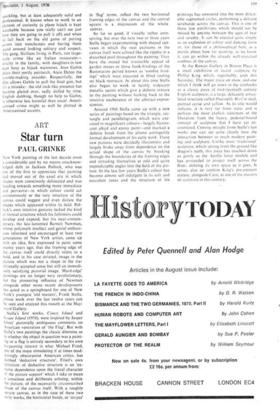ART
Star turn
PAUL GRINKE
New York painting of the last decade owes a considerable and by no means unacknow- 'edged debt to Jackson. Pollock, who was one of the first to appreciate that painting had moved out of the easel era in which shapes were consciously delineated and was heading towards something more immediate and pervasive—in which colour could act autonomously or the very structure of the canvas could suggest and even dictate the shapes which appeared within its field. Pol- lock's own intuitive gestures lacked the kind of formal structure which his followers could develop and expand; but his near-contem- porary, the late-lamented Barnett Newman, whose polymath intellect and genial enthusi- asm informed and encouraged at least two generations of New York artists, came up with an idea, first expressed in paint some twenty yews ago, that the framing edge of the canvas itself could directly relate to a bold, and in his case striated, image in the picture which was not a shape in the tra- ditionally accepted sense but still an immedi- ately satisfying pictorial image. 'Hard-edge' paintings are no longer very revolutionary, but the pioneering influence of Newman alongside other more recent developments has acted as a springboard for one of New York's youngest 'old masters', Frank Stella, .whose work over the last twelve years can he seen and enjoyed this mouth at the Hay- ward Gallery.
Stella's first works, Coney Island and Grape Island (1958), were inspired by Jasper Johns' pictorially ambiguous comments on American veneration of 'the Flag'. But with Stella's two paintings the classic dilemma as to whether the object in question was a paint- ing or a flag is entirely secondary to his own burgeoning interest in what Michael Fried,. one of the more stimulating if at times mad- deningly obscurantist American critics, has dubbed 'deductive structure'. Fried's own definition of deductive structure is an 'ex- treme dependence upon the literal character of the picture support' which I take to mean a conscious and deliberate echoing, within the picture, of the necessarily circumscribed shape of the canvas itself. With a roughly square canvas, as in the case of these two early works, the horizontal bands, or 'stripes'
in tag' terms, reflect the two horizontal framing edges of the canvas and the central square is a microcosm of the whole canvas.
So far so good, if visually rather unin- spiring, but over the next two or three years Stella began experimenting with shaped can- vases in which the neat excisions in the canvas itself were echoed like the ripples in a disturbed pool throughout the painting. They have the muted but irresistible appeal of garden mazes or those book-bindings of the Restoration period known as 'sombre bind- ings' which were executed in blind tooling on black morocco. At about this time Stella also began to work in faintly iridescent metallic paints which give a definite texture to the painting without harking back to the intuitive exuberance of the abstract-expres- sionists.
Around 1966 Stella came up with a new series of paintings based on the triangle, rec- tangle and parallelogram, which were exe- cuted in magnificent colours—largely fluores- cent alkyd and epoxy paint—and marked a definite break from the almost astringently formal development of his early work. These new pictures were decidedly illusionistic and largely broke away from dependence on the actual shape of the canvas by breaking through the boundaries of the framing edges and intruding themselves at odd and quite unpredictable angles into the field of the pic- ture. In the last few years Stella's colour has become almost self-indulgent in its soft and succulent tones and the structure of his
paintings has unwound into the most delect- able segmented circles, performing a delicate sarabande across the canvas. This is one of those few exhibitions which should not he missed by anyone between the ages of two and seventy. It can be enjoyed quite simply as an explosion of colour and dancing form or. for those of a philosophical bent, as a puzzle about how far painting, as we know it. can go within the already well-stretched confines of the canvas.
At the Rowan Gallery in Bruton Place is a small exhibition of recent s.culpture by Phillip King which, regrettably, ends this Saturday. The major piece on show, and one which I think will go down in the textbooks as a classic piece of mid-twentieth century English sculpture, is a large, delicately articu- lated structure called Dm:stable Reel in steel, painted cerise and yellow. As its title would indicate, it is very far from static and is perhaps the most explicit statement of the liberation from the heavy, pedestal-bound concept of sculpture that I have yet en- countered. Coming straight from Stella's last works one can see quite clearly here the interaction between so much modern paint- ing and sculpture. Unlike most 'traditional' sculpture, which sprang from the ground like dragon's teeth, this piece has touched down as gently as the Apollo lunar module and has proceeded to project itself across the floor, defining its own space as it goes. It serves also to confirm King's pre-eminent stature, alongside Caro, as one of the masters of sculpture in this century.






























 Previous page
Previous page